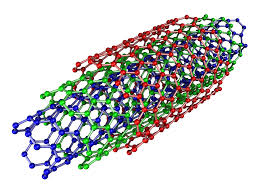Shrinking Carbon Nanotubes

Multi walled nanotubes
Carbon nanotubes have a wide range of applications in medicine from artificial muscles and artificial retinas to heart patches, brain electrodes, smart skin, supports for nerve growth, and various kinds of biosensors. The finer the application the necessarily smaller the nanotube, but until now it hasn’t been possible to reduce their size to the theoretical limit. This pieces describes how engineers at Xiamen University (southeastern coast of China) were able to reduce nanotube size: “Using a transmission electron microscope (TEM) to irradiate double-walled carbon nanotubes with electron radiation, combined with thermal annealing at 1200°C, [researchers] watched as their carbon nanotubes shrank. Surprisingly, the irradiation didn’t introduce any disorder and the mass-reduction was even, rather than random. Regular kinks appeared in the TEM images, travelling up the length of the carbon nanotubes before finally disappearing and leaving behind a smaller tube that remained structurally pristine. They were able to shrink their carbon nanotubes from an initial diameter of 4.2nm down to 2.36nm after only 10 minutes.” MORE WITH VIDEO
Image Credit: commons.wikimedia.org


